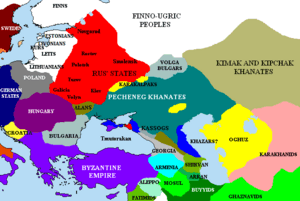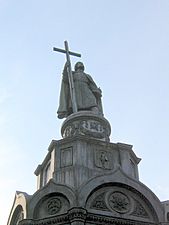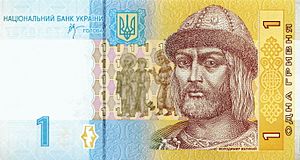Vladimir the Great facts for kids
Quick facts for kids Vladimir the Great |
|||||
|---|---|---|---|---|---|

Miniature from a 17th-century Menaion
|
|||||
| Grand Prince of Kiev | |||||
| Reign | 11 June 980 – 15 July 1015 | ||||
| Coronation | 11 June 980 | ||||
| Predecessor | Yaropolk I of Kiev | ||||
| Successor | Sviatopolk I of Kiev | ||||
| Prince of Novgorod | |||||
| Reign | 969 – c. 977 | ||||
| Predecessor | Sviatoslav I of Kiev | ||||
| Successor | Yaropolk I of Kiev | ||||
| Born | c. 958 Budyatychi (modern Volyn Oblast, Ukraine) |
||||
| Died | 15 July 1015 (aged c. 57) Berestove (today a part of Kiev) |
||||
| Burial | Church of the Tithes, Kiev | ||||
| Spouse |
|
||||
| Issue among others |
|
||||
|
|||||
| Dynasty | Rurikids | ||||
| Father | Sviatoslav I of Kiev | ||||
| Mother | Malusha (probably of Northern origin) | ||||
| Religion | Christianity (from 988) prev. Slavic pagan |
||||
Vladimir the Great (around 958 – 15 July 1015) was an important ruler of Kievan Rus'. He was first a prince of Novgorod, then became the grand Prince of Kiev. He ruled from 980 to 1015.
Vladimir's father was Prince Sviatoslav I of Kiev from the Rurik dynasty. After his father died in 972, Vladimir, who was then prince of Novgorod, had to escape to Scandinavia in 976. This happened because his brother Yaropolk had killed their other brother Oleg and taken over Kievan Rus'.
In Sweden, Vladimir gathered an army of Varangians with help from his relative Håkon Sigurdsson, the ruler of Norway. He then took Novgorod back from Yaropolk. By 980, Vladimir had united the lands of Kievan Rus'. This area stretched from modern-day Belarus, Russia, and Ukraine all the way to the Baltic Sea. He also made the borders strong against attacks from different groups like the Bulgarians, Baltic tribes, and nomads from the East.
At first, Vladimir followed Slavic paganism, which was the old religion of his people. But in 988, he decided to become a Christian. After his own conversion, he made Christianity the main religion of Kievan Rus'.
Contents
How Vladimir Became Ruler
Vladimir was born in 958. He was the youngest son of Sviatoslav I of Kiev and his housekeeper, Malusha. Some old stories say Malusha was a prophetess who lived to be 100 years old. Malusha's brother, Dobrynya, was Vladimir's teacher and a very trusted helper. Some traditions also link Vladimir's childhood to his grandmother, Olga of Kiev. She was a Christian and ruled the capital while Sviatoslav was away fighting wars. Vladimir was born either in Budyatychi (in modern Volyn Oblast, Ukraine) or Budnik (in modern Pskov Oblast, Russia).
In 969, Sviatoslav moved his capital and made Vladimir the ruler of Novgorod the Great. But he gave Kiev to his older, official son, Yaropolk. After Sviatoslav died in 972, a war started in 976 between Yaropolk and his younger brother Oleg. In 977, Vladimir escaped to his relative Haakon Sigurdsson, the ruler of Norway. He gathered many Norse warriors to help him get Novgorod back.
When he returned the next year, he marched towards Yaropolk. On his way to Kiev, he sent messengers to Rogvolod, the prince of Polotsk. Vladimir wanted to marry Rogvolod's daughter, Rogneda. But the princess refused to marry him because he was the son of a housekeeper. So, Vladimir attacked Polotsk, killed Rogvolod, and made Rogneda his wife. Polotsk was an important fort on the way to Kiev. Capturing Polotsk and Smolensk helped him take Kiev in 978. There, he tricked and killed Yaropolk and was declared the knyaz (prince) of all Kievan Rus'.
Vladimir's Time as a Pagan Ruler
Vladimir continued to make his lands bigger, even more than his father had. In 981, he took the Cherven towns from the Poles. In 981–982, he stopped a rebellion by the Vyatichi people. In 983, he took control of the Yatvingians. In 984, he conquered the Radimichs. And in 985, he led a military campaign against the Volga Bulgars, building many forts and settlements along the way.
Even though Christianity had started to spread in the area, Vladimir remained a strong follower of paganism. He had many wives and built pagan statues and shrines to his gods. He tried to change Slavic paganism to connect himself with the different gods his people worshipped. He built a pagan temple in Kiev dedicated to six gods. These included Perun, the god of thunder and war, and Mokosh, a goddess representing Mother Nature.
His pagan practices caused problems. People in Rus' were upset when their gods were openly disrespected. This led to conflict, and some Christians faced difficulties.
However, Prince Vladimir thought about these events for a long time, also considering political reasons. According to an old Slavic book called the Tale of Bygone Years, he sent his messengers to different parts of the world. Their job was to learn about the major religions of that time: Islam, Roman Catholicism, Judaism, and Byzantine Orthodoxy. The messengers were most impressed by their visit to Constantinople. They said, "We did not know whether we were in Heaven or on Earth... We only know that God lives there among the people, and their service is more beautiful than the ceremonies of other nations."
Kievan Rus' Becomes Christian

The Primary Chronicle says that in 987, after talking with his boyars (nobles), Vladimir the Great sent people to study the religions of nearby nations. These nations had been trying to convince him to join their faiths. The chronicler Nestor described what happened. The messengers reported that the Muslim Bulgarians of the Volga had no joy, only sadness and a bad smell. They also said Islam was not good because it did not allow alcoholic drinks or pork. Vladimir famously said, "Drinking is the joy of all Rus'. We cannot live without that pleasure."
Ukrainian and Russian sources also say Vladimir talked with Jewish messengers. He asked them about their religion but finally rejected it. He said that their loss of Jerusalem showed that God had left them.
His messengers also visited Christian missionaries from both the Latin (Western) and Eastern (Byzantine) churches. In the churches of the Germans, his messengers saw no beauty. But in Constantinople, where the full church service of the Byzantine Church was performed to impress them, they found what they were looking for. They reported, "We no longer knew whether we were in heaven or on earth," describing a grand Divine Liturgy in Hagia Sophia. "Nor such beauty, and we know not how to tell of it." Vladimir was very impressed by this story from his messengers.
In 988, Vladimir captured the town of Chersonesos in Crimea. He then bravely asked to marry Anna, the sister of Emperor Basil II. No Byzantine imperial princess, especially one "born in the purple" (meaning born while her father was emperor), had ever married a "barbarian" before. French kings and German emperors had been turned down. So, marrying the 27-year-old princess to a pagan Slav seemed impossible.
However, Vladimir was baptized at Chersonesos. He took the Christian name Basil to honor his imperial brother-in-law. After his baptism, he married Anna. When he returned to Kiev in triumph, he destroyed pagan monuments. He also built many churches, starting with one dedicated to St. Basil, and the Church of the Tithes (in 989).
Some Arab sources, both Muslim and Christian, tell a different story about Vladimir's conversion. Many historians like Yahya of Antioch and ibn al-Athir give a similar account. In 987, two rebels, Bardas Sclerus and Bardas Phocas, rebelled against the Byzantine emperor Basil II. Basil II asked Kievan Rus' for help, even though they were enemies at the time. Vladimir agreed, but only if he could marry Anna. He also agreed to become Christian and to make his people Christian. Once the marriage plans were set, Vladimir sent 6,000 soldiers to the Byzantine Empire. They helped put down the rebellion.
In 988 and 991, he also baptized Pecheneg princes Metiga and Kuchug.
Vladimir's Christian Rule

Vladimir then created a large council of his boyars. He placed his twelve sons in charge of different parts of his lands. According to the Primary Chronicle, he founded the city of Belgorod in 991. In 992, he went on a campaign against the Croats, likely the White Croats living near modern Ukraine. This campaign was cut short because the Pechenegs attacked areas around Kiev.
In his later years, he lived mostly in peace with his neighbors. These included Boleslav I of Poland, Stephen I of Hungary, and Andrikh the Czech. After Anna died, he married again, possibly to a granddaughter of Otto the Great.
In 1014, his son Yaroslav the Wise stopped paying tribute (money paid to the ruler). Vladimir decided to punish his son and began gathering troops against him. However, Vladimir became ill, likely from old age, and died at Berestove, near Kiev. His body was divided and sent to his many holy churches. These parts were then honored as relics.
During his Christian rule, Vladimir followed the teachings of the Bible by doing many acts of charity. He would give out food and drink to people who were less fortunate. He also made an effort to go out to help those who could not reach him. He built many churches, including the Church of the Tithes (989). He also started schools, protected the poor, and set up church courts. He lived mostly in peace with his neighbors, with only attacks from the Pechenegs disturbing his calm.
Family
Vladimir had many children, including several sons and daughters. Some of his notable children include:
- Sviatopolk the Accursed (born around 979), who may have been the son of Yaropolk.
- Izyaslav of Polotsk (born around 979), Prince of Polotsk.
- Yaroslav the Wise (born no earlier than 983), who became Prince of Novgorod and later Grand Prince of Kiev.
- Mstislav of Chernigov (born around 983), Prince of Tmutarakan and later Prince of Chernigov.
- Boris (born around 986) and Gleb (born around 987), who became saints.
- Sudislav (died 1063), Prince of Pskov.
- Maria Dobroniega of Kiev (born around 1012), who became the Duchess of Poland.
The exact number and fate of all his children are not fully known, but they played important roles in the history of Kievan Rus'.
Vladimir's Importance and Legacy
The Eastern Orthodox, Byzantine Rite Lutheran, and Roman Catholic churches celebrate the feast day of St. Vladimir on 15/28 July.
The town Volodymyr-Volynskyi in north-western Ukraine was founded by Vladimir and is named after him. Another town, Vladimir in Russia, is usually said to be founded by Vladimir Monomakh. However, some researchers believe it was also founded by Vladimir the Great.
St Volodymyr's Cathedral, one of the largest cathedrals in Kiev, is dedicated to Vladimir the Great. The Imperial Russian Order of St. Vladimir and Saint Vladimir's Orthodox Theological Seminary in the United States are also named after him.
People also remember Vladimir through many Russian folk songs and legends. They often call him Krasno Solnyshko, which means Fair (or Red) Sun. With Vladimir, the Varangian period of Eastern Slavic history ended, and the Christian period began.
During his rule, all parts of the economy grew. He made coins and managed foreign affairs with other countries, especially trade. Through trade, he brought Greek wines, Baghdad spices, and Arab horses to sell in the markets of Kiev.
Images for kids
-
Vladimir the Great on the Millennium of Russia monument in Novgorod
-
Monument to Vladimir the Great and the monk Fyodor at Pushkin Park in Vladimir, Russia
See also
 In Spanish: Vladimiro I de Kiev para niños
In Spanish: Vladimiro I de Kiev para niños









